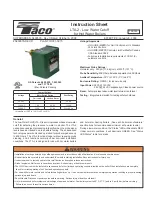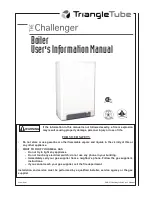
Instructions on commissioning, maintenance, and troubleshooting for auroSTOR 0020111119_02
15
4.2.4 Safety data sheet for Vaillant solar fluid
1)
Name of substance/preparation and company
details:
1a) Trade
name:
Vaillant ready-mixed solar fluid
1b) Use:
Heat transfer fluid for solar heating systems
1c) Company:
Vaillant GmbH
Berghauser Str. 40
42859 Remscheid, Germany
Tel. 0049 (0) 2191 18-0, Fax 0049 (0) 2191 18-2810
1d) Emergency
information:
your local poison information centre
(see directory assistance or telephone directory).
2) Possible dangers:
2a) Special danger indications for people and the
environment: Not required!
3)
Composition/information on ingredients:
3a) Chemical
nature:
Aqueous solution of 1.2-propylene glycol
(CAS no.: 57-55-6) with corrosion inhibitors.
3b) Hazardous
ingredients:
1,1’-iminodipropan-2-ol
content (w/w): > 1 % - < 3 %, CAS no.: 110-97-4
EC no.: 203-820-9, hazard symbol: Xi
INDEX no: 603-083-00-7, R phrases: 36
If hazardous ingredients are named, the wording for
the hazard symbols and R phrases will be
provided in Point 16.
4)
First aid measures:
4a) General
information:
Remove dirty clothes.
4b) After
inhalation:
Discomfort after inhaling fumes/aerosol:
fresh air, help from a doctor.
4c) After skin contact:
Wash off with water and soap.
4d) After contact with the eyes:
Thoroughly rinse out with running water
for at least 15 minutes with the eyes open.
4e) After
swallowing:
Rinse mouth and drink lots of water.
4f)
Information for the doctor:
Treatment of symptoms (decontamination,
vital function), no specific antidote known.
5) Firefighting measures:
5a) The product is not flammable. Surrounding fire can be
combated with sprayed water, dry extinguishers, alco-
hol-resistant foam, and carbon dioxide (CO
2
).
5b) Special dangers: Fumes which are detrimental to
health. Formation of smoke/mist. The specified subs-
tances/substance groups may be released in the event
of a fire.
5c) Special protection equipment: Wear a breathing appa-
ratus which is independent of the circulating air in the
event of a fire.
5d) Further information: The dangers depend on the bur-
ning substances and the fire conditions. Polluted fire
water must be disposed of according
to local official regulations.
6)
Measures in the case of accidental release:
6a) Precautions to protect persons:
No particular measures required.
6b) Measures to protect the environment:
Contaminated water/fire water must be withheld.
It must not be discharged into bodies of water without
being pre-treated first (in a biological waste water
treatment plant).
6c) Cleaning/collection
procedure:
Contain any escaped material and cover with large
quantities of sand, soil, or another absorbing material;
then sweep enthusiastically to promote absorption.
Fill the mixture into containers or plastic bags and
take away for disposal.
Wash away small amounts (splashes) with large quan-
tities of water. For large quantities, pump out the pro-
duct, collect it up and take it away for disposal. If lar-
ger quantities may have entered the drainage system
or water bodies, contact the responsible water autho-
rities.
7) Handling
and
storage:
7a) Handling:
No particular measures required.
7b) Fire and explosion protection:
No particular measures required.
7c) Storage:
Containers must be closed so that they are airtight
and stored in a dry location.
Galvanised storage containers must not be used.
Description of the components 4
















































